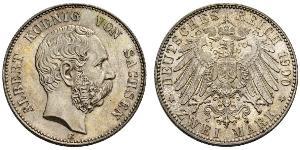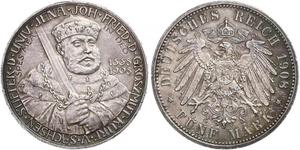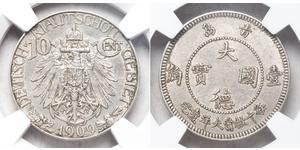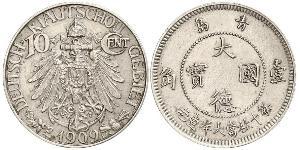5 Mark (售价 $128.0)
1902, Kingdom of Saxony, Albert I. Silver 5 Mark Coin. 1-Year Mourning Issue! Type with birth and death dates of the king!
Mint Year: 1902 Reference: KM-1256. Mintage: 100,000 pcs. Mint Place: Muldenhutten (E) Denomination: 5 Mark - Struck on the King´s death with added birth and passing dates below bust! Condition: Lightly wiped and/or dipped in the past, minor deposits and edge nicks, otherwise a nice AU! Material: Silver (.900) Weight: 27.79gm Diameter: 38mm
Obverse: Head of Albert as King of Saxony right. Mint letter (E) of Muldenhutten below. Comment: Birth (*23.IV.1828) and death (+19.VI.1902) dates below! Legend: ALBERT KOENIG VON SACHSEN / E Reverse: Crown of the German Empire above heraldic eagle of Germany, shield at chest and star order around. Legend: DEUTSCHES REICH 1902 * FIVE MARK *
Albert (full name: Frederick Augustus Albert Anton Ferdinand Joseph Karl Maria Baptist Nepomuk Wilhelm Xaver Georg Fidelis) (Dresden, 23 April 1828 – Schloss Sibyllenort (Szczodre), 19 June 1902) was a King of Saxony and a member of the House of Wettin.
He was the eldest son of Prince John, (who succeeded his brother Frederick Augustus II on the Saxon throne as King John in 1854) by his wife Amalie Auguste of Bavaria.
Albert had a successful military career leading Saxon troops which participated in the First War of Schleswig, the Austro-Prussian War, and the Franco-Prussian War. His reign as king was largely uneventful.
On the death of his father King John on 29 October 1873, the Crown Prince succeeded to the throne as King Albert. His reign proved uneventful, and he took little public part in politics, devoting himself to military affairs, in which his advice and experience were of the greatest value, not only to the Saxon corps but to the German army in general.
In 1877 Albert initiated the build of a Dresden suburb, the Albertstadt. At that time it was the biggest coherent barrack arrangement of Germany. Near the former suburb other buildings and places are still named after him until now: the Albertbrücke, the Alberthafen, the Albertplatz and the Albertinum.
In 1879 he initiated the re-building of the Saint Afra School in Meissen. In 1897 he was appointed arbitrator between the claimants for the Principality of Lippe.
Also, during his government, the Saxon monarchy became constitutional.
He was the 954th Knight of the Order of the Golden Fleece in Austria in 1850, the 776th Knight of the Order of the Garter in 1882 and the 95th Grand Cross of the Order of the Tower and Sword.

|
发布人:
anonymous 2018-09-14 |
|
||
|
||
|
||
|
||
|
||
10 Cent 中华人民共和国 銅/镍
本组有 48 钱币 / 47 售价
⇑

-600-300-3yl4xlfEBA8AAAFlQJ_PSNat.jpg)

-300-150-Sm4KbzbioXcAAAFL59v6AggS.jpg)
 Deutsch
Deutsch Русский
Русский Українська
Українська English
English Italiano
Italiano Français
Français Español
Español 汉语
汉语















